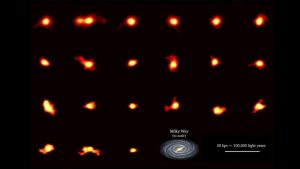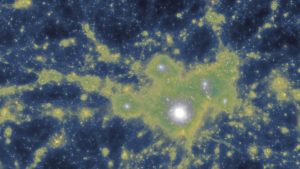
LIGO and Virgo detectors catch first gravitational wave from binary black hole merger with unequal masses, modeling shows big galaxies get bigger by merging with smaller ones, and new results from ALPINE reveal what appear to be spiral galaxies in the infant universe.
Links
A signal like none before
- LIGO and Virgo detectors catch first gravitational wave from binary black hole merger with unequal masses (Albert Einstein Institute)
- GW190412: Observation of a Binary-Black-Hole Coalescence with Asymmetric Masses (ArXiv.org)
New results from ALPINE reveal what appear to be spiral galaxies in the infant universe
- Rotating Galaxies Galore (CalTech)
Modeling shows big galaxies get bigger by merging with smaller ones
- Hungry galaxies grow fat on the flesh of their neighbors (ScienceinPublic)
Transcript
This is the Daily Space for today, Thursday, April 23, 2020. I am your host Dr. Pamela Gay, and I am here to put science in your brain.

Even though things here on earth are slowing to a punctuated shelter-in-place, the universe just keeps doing its thing, spewing out events at its regular and random cadence. While most observatories on the ground have shut down, their observations from their most recent runs are still being processed. This means that while there will be some future dead time when no results are coming our way, we haven’t hit that point yet because there is a lag between when observations are made and when they are analyzed and published. This lag means that while the LIGO gravitational wave detectors are currently shut down, we have a cool new result about a GW that was detected last year: GW190412. Just a year after it’s detection, a new paper posted on arxiv.org describes how an 8 Solar Mass and 30 solar mass pair of black holes merged into a new and greater black hole. Until now, the majority of LIGO’s BH-BH detections have been similarly sized black holes merging with a characteristic “Woooop” which increases in pitch without a lot of harmonics. With these asymmetric masses, the waves have overtones, more like how one string on a guitar will create overtones over a sympathetically resonating guitar cavity. Different shaped cavities, or in this case different sized distortions in space time, resonate differently, and we can see these resonances in the LIGO detections. This kind of an asymmetric observation isn’t unexpected: Black holes should come in a variety of sizes. This is just the first time we’ve seen this, and firsts are good, because they confirm the universe works the way we expect. In this case, the huge difference in mass between the two black holes indicates this may be a multi-generational merger, with the 30 solar mass black hole originating through the merger of other smaller black holes. This is, after all, the story of our universe – smaller things forever merging into larger and larger objects. GW190412 is just 1 of 56 events in the most recent observing run performed by LIGO. We all look forward to seeing what is lurking in those other 55 events. Some will likely turn out to be something here on Earth jiggling the system, but others… well… we’re just going to have to wait for those publications to see.

As we build better detectors and more powerful telescopes, we’re getting confirmation of many of our theories on how the universe evolved from a soup of H, He, and trace elements to being the “full of galaxies full of stars surrounded by planets” universe we experience. The rate at which things form is one of the things we have constantly underestimated, and new research is showing us once again how much the universe out performed our imaginations in how rapidly it formed galaxies. New observations from the Atacama Large Millimeter Array have shown how 118 galaxies are spiraling and merging in the early universe, roughly 1 to 1.5 billion years after the Big Bang. These systems are detected in ionized carbon, which shines bright in the colors easily detected by ALMA. When these submillimeter images are combined with Data from Keck, Hubble, and Spitzer, astronomers can piece together the galaxy masses, and how coherently these systems are rotating, and where mergers are taking place. They found that at this early age of the cosmos, 15% of the galaxies were already well ordered and smoothly rotating like spiral galaxies. While the data isn’t good enough to see structures like spiral arms, it is remarkable to see what we do see. This work was done by the ALPINE collaboration led out of CalTech and is published in the Astrophysical Journal supplement series.

From their formations in the early universe and through to today, these galaxies will continue to grow through mergers and by acquiring gas and dust from the intergalactic medium. In a new paper in the Astrophysical Journal, scientists led by Anshu Gupta try to understand this process using a combination of observations and computer models that add in the invisible effects of dark matter. By look at motions within massive galaxies that had already formed just a few billion years after the Big Bang, they were able to determine that the majority of stars had probably been cannibalized from systems that got too close and got eaten up. Since these systems had their own peculiar motions, the resulting galaxies are observed to have disorganized stellar motions. In what is one of my favorite quotes in a press release, Kim-Vy Tran, a co-author on this work, explains, “The surviving galaxies have grown fat and disorderly through incorporating smaller ones. I think of it as big galaxies having a constant case of the cosmic munchies.”
And really there is nothing I can say that is better than that.
<———————>
Thank you all for listening. Today’s script was written by Pamela Gay, and the Daily Space is produced by Susie Murph. The Daily Space is a product of the Planetary Science Institute, a 501(c)3 non profit dedicated to exploring our Solar System and beyond. We are here thanks to the generous contributions of people like you. The best way you can support us is through Patreon.com/cosmoquestx Like us? Please share us! You never know whose life you can change by adding a daily dose of science.


 We record most shows live, on Twitch. Follow us today to get alerts when we go live.
We record most shows live, on Twitch. Follow us today to get alerts when we go live.